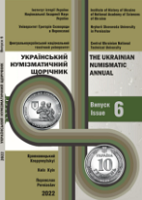ДОСЛІДЖЕННЯ КАРБУВАННЯ ЗОЛОТИХ МОНЕТ 21-ГО РОКУ ПРАВЛІННЯ ХОСРОВА ІІ (590-628 РР.)
A DIE STUDY OF THE YEAR 21 GOLD COINS OF KHUSRO II (590–628)
Author(s): Susan Tyler-SmithSubject(s): Cultural history, Museology & Heritage Studies, Economic history, 6th to 12th Centuries
Published by: ДВНЗ Переяслав-Хмельницький державний педагогічний університет імені Григорія Сковороди
Keywords: Sasanian; Khusro II; gold coins; dinars; die study; xwarrah;
Summary/Abstract: This paper discusses two denominations of gold coins struck by the Sasanian king of kings, Khusro II (590–628). They both have the same design. On the obverse is the profile head of the king facing right, similar to that found on the silver but without the marginal stars and crescents. The legend on the left is the same as that on the drachms but there is a longer legend on the right so the whole legend reads: 'Khusro king of kings has increased the royal glory‘. On the reverse there is a facing bust with the head surrounded by flames, similar to that seen on some 'special‘ issue silver drachms. There have been a number of different identifications of this bust, the most plausible being that it is the personification of xwarrah, the 'Royal Glory‘, a concept that was very important to Khusro II. There is no mint on these gold coins but there is a date, regnal year 21(610/11), on the left. On the right the legend reads: 'he (= Khusro II) has increased Ērān, he is well-omened‘. Gold coins were struck in small quantities by most Sasanian kings. It appears tohave been mostly a ceremonial coinage, with only Shapur II (309–79) and Peroz (459–84) striking larger amounts. Khusro II‘s gold coinage is relatively plentiful when compared to that of other late Sasanian rulers. Khusro II‘s predecessor, Hormizd IV(579–90), struck no gold coins and only five coins of Khusro I (531–79) have been recorded. The usurper Vahran VI (590–1) is the sole other late Sasanian king whose gold coins have survived in comparatively large numbers. The larger of Khusro‘s two denominations, the heavy (or 1½) dinar, is known from three specimens, plus another which has been over-struck as an Ilkhanid dinar of Abu Said (1316–35). The smaller denomination, the light (or 1) dinar, is more plentiful with over 50 coins recorded. The year 21 gold coinage was struck using three obverse and three reverse dies, one pair of dies being used for both the heavy and light dinar coins. Two obverse and reverse dies were used together but the third pair has not yet been linked to them. As light dinars of Khusro II are regularly seem in commerce this picture may change. The gold coins have been listed and the source of each coin noted (Table 1). All the dies have been identified, and the available physical information, weight, diameter and die axis, has been added. The result shows that two pairs of dies were used to strike 42 out of the 53 light dinars and also the three heavy dinars. The other die pairings struck many fewer coins: one pair struck eight coins, one pair struck two coins and one pair struck one coin. A number of the coins are double struck on both obverse and reverse and one reverse die has a flaw across the neck and shoulder of xwarrah (reverse die 1). Die flaws and double striking are frequently seen on the drachm coinage and it is evident that the mint did not take especial care when producing the gold. The average weight of the light or 1 dinar coins is 4.56 grams (with a mean of 4.57 grams). The average of the four heavy dinars is about 6.73 grams but with so few coins one cannot arrive at any definitive result regarding the weight. The relationship between these two denominations is not clear (4.57g x 1½ = 6.855g). The diameters of the light dinars vary between 21.3 and 23.5 millimetres (from 16 specimens). The diameters of the heavy dinars are similar, as one would expect, varying between 22 and 22.7 millimetres. The exception is the over-struck coin which is larger.
Journal: Український Нумізматичний Щорічник
- Issue Year: 2022
- Issue No: 6
- Page Range: 181-197
- Page Count: 17
- Language: Ukrainian

